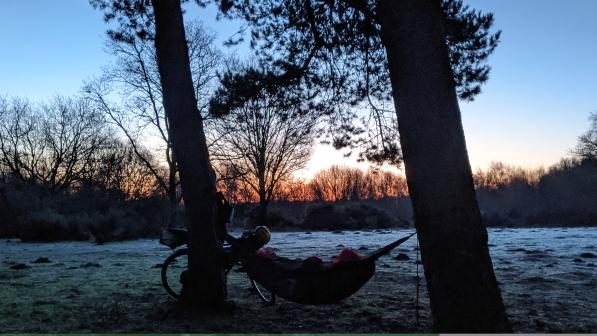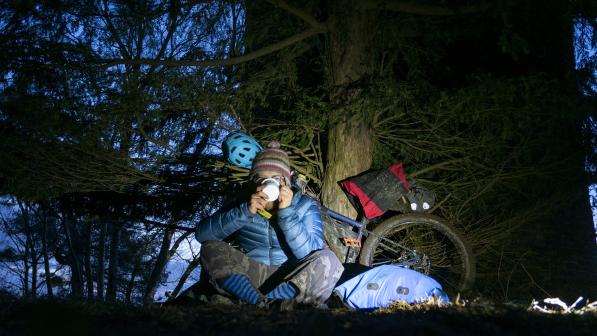Will I be safe to go wild camping alone?

“Cycling for long distances and all sounds great. But how did you always find a decent place to sleep during the night?” is a question that I’ve been asked multiple times with regards to my cycling adventures.
A simple answer to that would be that I didn’t. It wasn’t every night that I got a chance to check into a hotel and sleep in a bed with a fluffy mattress, comfortable pillows, a soft and weighty duvet, all the required charging spots, a hot shower and a chance to clean the clothes that I spent most of the days wearing.
In fact, most nights, I’d wild camp somewhere for a good night’s sleep before hopping back on the bike in the dawn.
“What is this “wild camping” jazz though? And how on earth is it even comfortable?”, I hear you ask.
Well, wild camping means spending the night somewhere that’s not a campsite. As in, you head out in the wild, look out for some place that looks relatively hidden that you can pitch your tent or bivi at and then create a setup that works for you to spend the night comfortably.
We’re just not used to being alone in the wild. Consider this as a date with yourself
Vedangi Kulkarni
My first ever solo “wild camping” experience was back in early 2017. It was my first 600km ride in one go and I had left home at 21:00, in hopes of getting over my irrational fear of cycling solo through the night.
At approximately 02:30, 120 ish km later, I happened to cycle past a bus shelter. I didn’t really give it a second thought. 10 minutes later, it hit me just how tired and sleepy I was and I went back to check if that bus shelter actually existed or if I had made it up.
As it turned out, it was very much real and I was rather sleepy. With no sleeping bag, bivi bag, sleeping mat or anything as such, I just wore the rest of the clothes that I had carried in my bag in a failed attempt of keeping warm. I held very tightly onto my bike and fell asleep until sunrise.
While it wasn’t the most relaxing sleep, I clearly remember feeling a great sense of achievement owing to the fact that I had actually acknowledged my fear, rationalised with it and gone beyond it.
A little over a year after that, my bike Cappuccino and I wild camped in some of the most bizarre places including (but not limited to) those massive roadside pipelines, random benches found in lay-bys along main roads, ledges under bridges, behind gas stations, toilets, other people’s gardens (with their permission, of course), in forests, next to lakes, under trees, roadside ditches (only where it seemed relatively safe), self-made snowholes and of course…bus shelters.

Every unique sleeping arrangement stretched my definition of “comfort” and eventually I was able to nail down exactly what worked for me and gave me a chance to recover from a day’s riding.
There were a lot of things that became “obvious” only when I’d gone out and wild camped solo a fair few times. Of course, I had read up what I thought was relevant on the internet and taken some lessons from adventure books. But, to reiterate my earlier point, the term “comfort” is relative and what works for some may not work for the others.
Having said that, here’s five things that can make your first solo camping experience just that little less daunting.
Setup
You want your first experience to be joyful and mostly hassle-free. So, look at where you’re allowed to camp, In England, Dartmoor National Park is your best bet where wild camping is allowed.
If not, look for the closest national park to where you live. Scout for some place you could ride to and set up a camp a day or two before, just in case. Ideally, you want to find a clearing amongst some trees with flat ground to set yourself up.
You don’t want to be easily seen by any passers by, so try and be way off the trail/road that you’re riding on. Stealth mode is the way to go! Remember to check if the area you’re thinking of camping at is a conservation area. If it is, then it’s best not to camp around there. The idea is to co-operate with nature and try not to harm it whilst you enjoy its benefits.
Oh, and if you’re still worried, speak to the landowner and get their permission in advance so that you don’t sleep with a worry of having accidentally offended someone.
What to carry?
First things first, please carry a head torch. I promise you that it is very annoying to hold a bike light in your mouth whilst trying to set things up.
A tent and associated equipment or a bivi bag, sleeping mat, sleeping bag with/without a tarp or a hammock- the choice is yours! Ideally, you want to be warm and comfortable while setting up the camp as well as through the night.
A few things to remember to carry: waterproof jacket, some layers, down jacket, hat, gloves, warm socks, gas canister, stove, container to boil water, powdered hot chocolate, spork, lighter, food, lots of water, loo roll, a bag to put all the rubbish in, etc.
Safety and Security
Acknowledge your fears. Create a mental risk assessment. And try not to watch a horror or psychological thriller before your first ever solo wild camping experience. Most of my irrational night cycling and solo camping fears are rooted from those films.
On a more practical level, make sure that you choose a relatively hidden spot for camping. If you’re worried about your bike, lock it with one of those zip or wire locks.
Ask the people that you know who’ve been wild camping before about where they went and choose a location you personally feel comfortable with. Look up for any things that could potentially fall on you, and look down for any insects or other critters. I once camped very close to an anthill. You really don’t wanna know the rest of the story...
Problem-solving
If you don’t have a tent and you’re worried about the ground being soggy, and don’t feel very confident about your sleeping mat or bivi bag coping with it, carry a massive bin bag to put under the sleeping mat. If you’re worried about getting your period or changing your menstrual cup, make sure you set up a camp nearby a water source in case anything needs washing.
Keep it simple and comfortable as much as possible. Carry a rubbish bag for all sanitary waste including used toilet paper. If you need to answer nature’s call, find a stick and dig a deep hole at least 6in deep and 200ft away from a water source before you do your thing. Cover it up once you’re done. If you’ve forgotten any piece of kit, then find a bodge for it. Make sure you carry stuff that can be repurposed as something else. For the rest, bungee cords, re-adjustable zip ties and duct tape do the job! Some wise human once said, where there’s a problem, there’s always a solution!
Scared to be lonely
Rest assured, camping in a forest is never quite as silent as you might imagine. The fear of the dark and of the unknown is very much understandable.
We live in the times when we’re just not used to being alone in the wild. Consider this as a date with yourself.
Keep yourself busy. Make some food. Make some hot chocolate. Play some light music or podcast or audiobook. Read a book until you fall asleep.
If none of that works, make sure your ride to your solo wild camp is hard and tiring so that you’ll care significantly less about anything else other than sleep. That seemed to be the one that worked for me before I tried anything else.
If you’ve read this far, I am convinced that you really want to get out and sleep under the stars, in which case, what are you waiting for?





